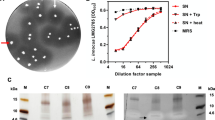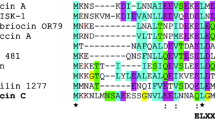Abstract
Objectives
To compare production of antibacterial liamocins (polyol lipids) by diverse strains of Aureobasidium pullulans grown on different culture media.
Results
Liamocins produced by strains of A. pullulans have potential agricultural and pharmaceutical applications as antibacterials with specificity against Streptococcus spp. Six strains of A. pullulans were characterized for liamocin production on four different culture media. The choice of strain and culture medium affected growth, liamocin yields, and production of contaminating pigments. Best growth and highest liamocin yields were obtained using A. pullulans strain NRRL 50384 grown on a sucrose basal medium. Unexpectedly, the choice of strain and culture medium also affected the structure of liamocins produced, providing novel types of liamocins. Liamocins varied not only in the ratios of trimer and tetramer polyester tail groups, but also in the nature of the polyol headgroup, which could include mannitol, arabitol, or glycerol.
Conclusions
The ability to conveniently produce novel types of liamocins in good yields will provide novel antibacterials for applied uses, and facilitate structure-function studies on the mechanism of antibacterial activity.

Similar content being viewed by others
References
Bischoff KM, Leathers TD, Price NPJ, Manitchotpisit P (2015) Liamocin oil from Aureobasidium pullulans has antibacterial activity with specificity for species of Streptococcus. J Antibiot. doi:10.1038/ja.2015.39
Doshida J, Hasegawa H, Onuki H, Shimidzu N (1996) Exophilin A, a new antibiotic from a marine microorganism Exophiala pisciphila. J Antibiot 49:1105–1109
Hibbett DS, Binder M, Bischoff JF et al (2007) A higher-level phylogenetic classification of the Fungi. Mycol Res 111:509–547
Isoda H, Nakahara T (1997) Antiproliferative effect of polyol lipids, 3,5-dihydroxydecanoyl and 5-hydroxy-2-decenoyl esters of arabitol and mannitol on lung cancer cell line A549. J Ferment Bioeng 84:403–406
Kim JS, Lee IK, Yun BS (2015) A novel biosurfactant produced by Aureobasidium pullulans L3-GPY from a tiger lily wild flower, Lilium lancifolium Thunb. PLoS One 10(4):e0122917
Kurosawa T, Sakai K, Nakahara T, Oshima Y, Tabuchi T (1994) Extracellular accumulation of the polyol lipids, 3,5-dihydroxydecanoyl and 5-hydroxy-2-decenoyl esters of arabitol and mannitol, by Aureobasidium sp. Biosci Biotechnol Biochem 58:2057–2060
Leathers TD (1989) Purification and properties of xylanase from Aureobasidium. J Ind Microbiol 4:341–348
Leathers TD (2002) Pullulan. In: Vandamme EJ, De Baets S, Steinbüchel A (eds) Biopolymers, Vol 6, polysaccharides II: polysaccharides from eukaryotes. Wiley, Weinheim, pp 1–35
Manitchotpisit P, Leathers TD, Peterson SW, Kurtzman CP, Li X-L, Eveleigh DE, Lotrakul P, Prasongsuk S, Dunlap CA, Vermillion KE, Punnapayak H (2009) Multilocus phylogenetic analyses, pullulan production and xylanase activity of tropical isolates of Aureobasidium pullulans. Mycol Res 113:1107–1120
Manitchotpisit P, Price NPJ, Leathers TD, Punnapayak H (2011) Heavy oils produced by Aureobasidium pullulans. Biotechnol Lett 33:1151–1157
Manitchotpisit P, Skory CD, Peterson SW, Price NPJ, Vermillion KE, Leathers TD (2012) Poly(β-L-malic acid) production by diverse phylogenetic clades of Aureobasidium pullulans. J Ind Microbiol Biotechnol 39:125–132
Manitchotpisit P, Watanapokasin R, Price NPJ, Bischoff KM, Tayeh M, Teeraworawit S, Kriwong S, Leathers TD (2014) Aureobasidium pullulans as a source of liamocins (heavy oils) with anticancer activity. World J Microbiol Biotechnol 30:2199–2204
Nagata N, Nakahara T, Tabuchi T (1993) Fermentative production of poly(β-L-malic acid), a polyelectrolytic biopolyester, by Aureobasidium sp. Biosci Biotechnol Biochem 57:638–642
Price NPJ, Manitchotpisit P, Vermillion KE, Bowman MJ, Leathers TD (2013) Structural characterization of novel extracellular liamocins (mannitol oils) produced by Aureobasidium pullulans strain NRRL 50380. Carbohydr Res 370:24–32
Schoch CL, Shoemaker RA, Seifert KA, Hambleton S, Spatafora JW, Crous PW (2006) A multigene phylogeny of the Dothideomycetes using four nuclear loci. Mycologia 98:1042–1053
Singh RS, Saini GK, Kennedy JF (2008) Pullulan: microbial sources, production and applications. Carbohydr Polymers 73:515–531
Wang C-L, Li Y, Xin F-H, Liu Y-Y, Chi Z-M (2014) Evaluation of single cell oil from Aureobasidium pullulans var. melanogenum P10 isolated from mangrove ecosystems for biodiesel production. Process Biochem 40:725–731
Acknowledgments
The authors thank Melinda Nunnally and Trina Hartman for expert technical assistance.
Author information
Authors and Affiliations
Corresponding author
Additional information
Mention of any trade names or commercial products in this publication is solely for the purpose of providing specific information and does not imply recommendation or endorsement by the US Department of Agriculture. USDA is an equal opportunity provider and employer.
Rights and permissions
About this article
Cite this article
Leathers, T.D., Price, N.P.J., Bischoff, K.M. et al. Production of novel types of antibacterial liamocins by diverse strains of Aureobasidium pullulans grown on different culture media. Biotechnol Lett 37, 2075–2081 (2015). https://doi.org/10.1007/s10529-015-1892-3
Received:
Accepted:
Published:
Issue Date:
DOI: https://doi.org/10.1007/s10529-015-1892-3




